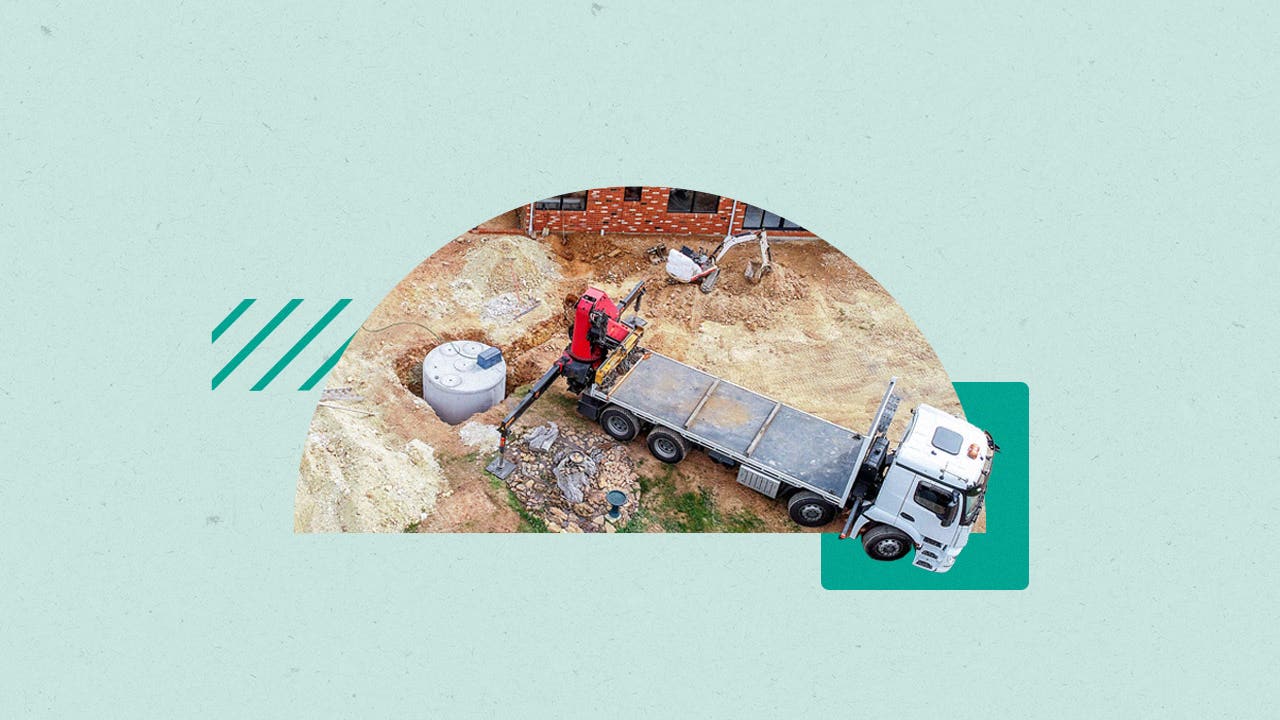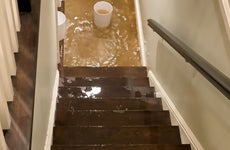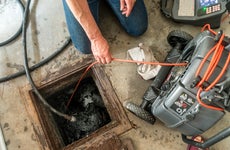Does homeowners insurance cover septic tanks?

The Bankrate promise
At Bankrate, we strive to help you make smarter financial decisions. To help readers understand how insurance affects their finances, we have licensed insurance professionals on staff who have spent a combined 47 years in the auto, home and life insurance industries. While we adhere to strict , this post may contain references to products from our partners. Here's an explanation of . Our content is backed by Coverage.com, LLC, a licensed entity (NPN: 19966249). For more information, please see our .
If you have a septic system rather than municipal sewer services, you know how important it is to properly maintain the tank and any plumbing associated with it. It can also be useful to know if and when your homeowners insurance covers septic. If you have a septic malfunction, you may be able to use your insurance to cover the costs — but that depends largely on the cause of the problem. Bankrate’s insurance editorial team took a close look at issues related to septic tank maintenance to determine if there is septic tank insurance and when it can be used.
Does homeowners insurance cover septic systems?
Usually, septic tanks fall into the other structures coverage portion of your homeowners insurance policy. This is the part of your policy that protects things on your property that are not attached to your house, like a gazebo, shed, detached garage and in many cases, your septic tank.
In general, home insurance policies extend other structures coverage as 10 percent of your dwelling limit. So if you have $300,000 in dwelling coverage, you would potentially have $30,000 in other structures coverage.
Your other structures coverage may kick in to help pay for repairs to your septic tank — or a full-on replacement — if the tank was damaged by a peril not excluded by your policy. If the top of your tank gets damaged in a fire, for example, your policy will typically cover the replacement.
Reviewing your insurance policy may help you understand which circumstances would apply if your septic system sustains damage or a loss. Standard HO-3 insurance policies cover other structures on an open perils basis, so you would have coverage for any peril not specifically excluded by your policy. You should also know that calling on your home insurance for other structures coverage likely means paying your deductible.
What are common reasons for septic system failure?
Septic system failure may happen for a number of reasons, not all of them covered by insurance. Here are a few you may have experienced with your septic system:
- Clogged drains: If a pipe is clogged or blocked, sewage may not be able to move to the tank. You can avoid this by only flushing or pouring acceptable substances into the drain. If a clog happens, a plumber may be able to snake out the line to allow liquid to flow again.
- Blocked inlet baffle: This is the part of your septic system that joins the pipes to the tank. A service professional can unclog it by opening the tank, if possible, or snaking the pipeline.
- Outlet baffle or filter is clogged: This may cause sewage to back up into the tank, and, even worse, into your home. One option if this happens is to have the tank drained and then remove the blockage.
- Drainfield failure: If your leach (aka drain) field becomes oversaturated with water, it may cause a backup of sewage into your home. You may notice a wet area around the drain field and increased odors. This may be due to a poorly operating system, or the drain field may be at the end of its usable life and need to be replaced.
By far, most septic failures are caused by poor installation and design or inadequate maintenance. In these cases, it is unlikely that your insurance will pay for repairs.
More infrequently, septic system failure may be caused by a sudden event, such as an earthquake, fire or vandalism. In cases such as these, you may be able to file a claim for repairs with your insurer. If you are unsure whether you are covered or not, it may be a good idea to contact your insurance agent, who can answer your questions.
What septic tank damage is typically covered by home insurance?
While there are many different types of home insurance, most standard policies cover septic tank damage from covered perils up to policy limits. Some common perils not excluded from standard home insurance policies include:
- Fire: If a fire causes damage to your septic system in any way, repairs may be covered by your policy.
- Vandalism and riots: If anyone intentionally damages your septic system as an act of vandalism or it gets damaged during civil unrest, it may be covered by your policy, depending on the circumstances.
- Hail, windstorms and lightning: Septic tank damage resulting from any of these severe weather types is likely to be covered.
- Explosions: Most homeowners insurance policies cover damage resulting from explosions. If this affects your septic tank or pipes, your insurance will usually kick in to cover the cost of repairs.
When are septic tanks not covered by home insurance?
As you might have noticed from the above list, homeowners insurance is most likely to cover septic tank damage when it results from a sudden, unexpected event. Your home insurance will likely not cover damage resulting from septic system problems caused by wear and tear or lack of maintenance. So if you let a nearby tree grow roots into the tank, for example, or regularly flush nonbiodegradable items into your septic tank, you may not qualify for a home insurance payout for repairs to the areas damaged.
Additionally, almost all home insurance policies specifically exclude coverage for damage caused by earthquakes and floods. Depending on where you live, you might consider adding separate flood or earthquake coverage.
Septic tank insurance
To further protect yourself financially from costs related to your septic system, you may want to consider adding coverage to your home insurance policy. Many standard homeowners insurance policies exclude the perils listed below. However, septic insurance can be available for homeowners through several possible endorsements and policy options.
Service line coverage
As a homeowner, you are the one financially responsible for the service lines that connect to and go out from your house, including the pipe that feeds to your septic tank. Some home insurance companies might let you add a service line coverage endorsement to your policy for minimal added cost to your policy. This endorsement protects your septic pipes, along with other water and sewage pipes, plus your power lines, internet cables and natural gas lines.
Water backup coverage
A septic backup can be an unwelcome surprise in your home or on your property. Fortunately, home insurance endorsements may provide financial protection from these events. Water backup coverage, or sump pump coverage, is a homeowners insurance endorsement that covers repair or restoration costs if water backs up into your home from sewer or drain lines.
Flood insurance
Flood damage is excluded from standard home insurance policies, but you may be able to purchase coverage through a private insurer or the National Flood Insurance Program (NFIP). Purchasing flood insurance may be a smart way to give yourself an extra layer of financial protection in case your septic tank is damaged in a flood.
How to take care of your septic tank
While water backup and service line endorsements may help you avoid some of the costs associated with septic tank repairs, it is your responsibility to keep your tank functioning at its best. That means you should avoid flushing the following items or dump them down the drain:
- Oils
- Solids like cigarette butts, paper towels, coffee grounds and feminine hygiene products
- Grease/fat
- Stains/paints
- Household chemicals
It’s also best practice to make sure that no vehicles drive over the septic system or its drainfield. Keep an eye out for nearby trees that might extend their roots into the septic lines, and monitor whether the tank has proper drainage.
The Environmental Protection Agency recommends getting your septic tank inspected every few years and pumped every three to five years. It also indicates that using water efficiently takes strain off your septic tank, helping ensure optimal performance over time.
Frequently asked questions
-
-
It depends. In general, your homeowners insurance policy will financially protect your septic tank and septic system against the same types of risks that the rest of your house is protected against. And, if you stay on top of regular maintenance and repairs, you may be able to avoid paying for costly septic tank repairs or replacements. However, some septic tank companies and private home warranty companies may offer warranties for service or maintenance of your septic system at an additional cost. This may provide another form of financial protection in case major repairs are necessary.
-
According to the Environmental Protection Agency, typical septic systems are made up of a tank, usually buried in your backyard, and a drain field. The tank — which is usually made of concrete, fiberglass or polyethylene — takes in organic matter from your home including wastewater, organic waste and other materials. It holds the wastewater until the solids settle in the bottom. The remaining liquids flow from the tank into the drain field, which is a covered excavation that allows the wastewater to disperse and ultimately flow into groundwater. As the wastewater percolates through the soil, bacteria, viruses and other substances are naturally removed. The solids must be periodically pumped out of the tank, usually every few years.
-
The cost of a septic system can vary, sometimes significantly, depending on the type of system and other factors. However, you’ll typically pay at least several thousand dollars for a new septic system. Some estimates put the cost of a new septic system at between $3,000–$9,000 for a three- to four-bedroom home, and newer technologies can land closer to $12,000–$18,000. Installation costs tend to increase that amount even further. Environmentally friendly aerobic systems tend to cost more than traditional anaerobic systems. The difference in these two systems has to do with whether they use oxygen to break down waste. Aerobic systems require a smaller leach field and are a good choice for smaller properties but tend to cost more as they require a power source to run properly.
-
Flood insurance may cover damage to your septic system but not necessarily flooding caused by your septic system. For example, if your home and yard are flooded, and your septic tank is damaged as a result of the flood, your flood insurance policy might help cover some of the septic repair costs. Flooding caused by your septic system, on the other hand, generally falls under sewer backup coverage, which is typically another separate endorsement and does not include coverage to repair the septic system itself — unless a covered peril was the cause of the backup.
-
Related Articles



